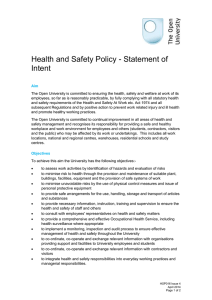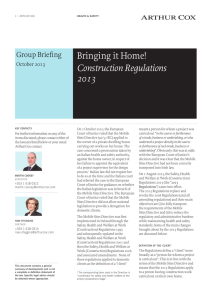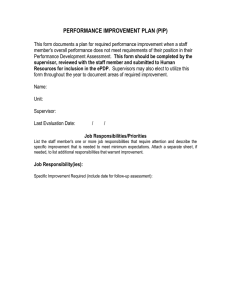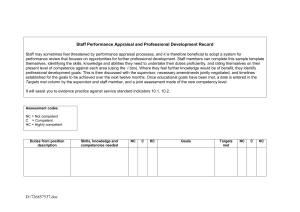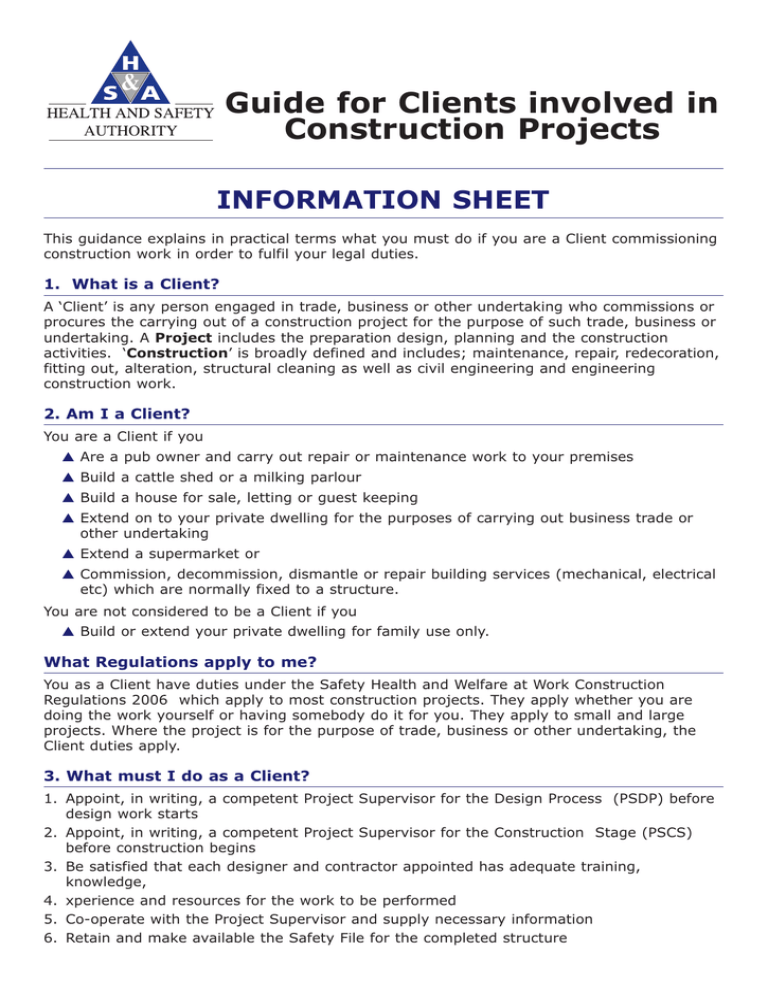
Guide for Clients involved in
Construction Projects
INFORMATION SHEET
This guidance explains in practical terms what you must do if you are a Client commissioning
construction work in order to fulfil your legal duties.
1. What is a Client?
A ‘Client’ is any person engaged in trade, business or other undertaking who commissions or
procures the carrying out of a construction project for the purpose of such trade, business or
undertaking. A Project includes the preparation design, planning and the construction
activities. ‘Construction’ is broadly defined and includes; maintenance, repair, redecoration,
fitting out, alteration, structural cleaning as well as civil engineering and engineering
construction work.
2. Am I a Client?
You are a Client if you
▲ Are a pub owner and carry out repair or maintenance work to your premises
▲ Build a cattle shed or a milking parlour
▲ Build a house for sale, letting or guest keeping
▲ Extend on to your private dwelling for the purposes of carrying out business trade or
other undertaking
▲ Extend a supermarket or
▲ Commission, decommission, dismantle or repair building services (mechanical, electrical
etc) which are normally fixed to a structure.
You are not considered to be a Client if you
▲ Build or extend your private dwelling for family use only.
What Regulations apply to me?
You as a Client have duties under the Safety Health and Welfare at Work Construction
Regulations 2006 which apply to most construction projects. They apply whether you are
doing the work yourself or having somebody do it for you. They apply to small and large
projects. Where the project is for the purpose of trade, business or other undertaking, the
Client duties apply.
3. What must I do as a Client?
1. Appoint, in writing, a competent Project Supervisor for the Design Process (PSDP) before
design work starts
2. Appoint, in writing, a competent Project Supervisor for the Construction Stage (PSCS)
before construction begins
3. Be satisfied that each designer and contractor appointed has adequate training,
knowledge,
4. xperience and resources for the work to be performed
5. Co-operate with the Project Supervisor and supply necessary information
6. Retain and make available the Safety File for the completed structure
7. Provide a copy of the safety and health plan prepared by the PSDP to every person
tendering for the project
8. Notify the Authority of the appointment of the PSDP where construction is likely to take
more than 500 person days or 30 working days (see form AF1)
9.
Allow a reasonable amount of time for project completion
4. When must I appoint Project Supervisors?
You must appoint in writing a competent Project Supervisors for the Design Process (PSDP)
before design work starts and a competent Project Supervisor for the Construction Stage
(PSCS) before construction work starts, in order to co-ordinate the design and construction.
They must acknowledge in writing that they accept the appointment. There can only be one
PSCS for one project at a given time.
You do not have to appoint Project Supervisors if the work is routine maintenance work such
as cleaning, decorating and repair and
▲ there is only one contractor involved;
▲ the project does not last longer than 30 days or 500 person days:
▲ the work does not involve a particular risk e.g. Working in deep trenches and
excavations, falling from a height where there is an aggravated risk of injury, use of
chemical or biological substances, including work involving asbestos ,work with ionising
radiation ( usually x-ray examination of structural joints etc.), work near high voltage
power lines, work over or near water, work in confined, unventilated spaces, work
carried out by drivers using an air supply system, work in a compressed air atmosphere,
work involving the assembly or dismantling of heavy prefabricated components.
5. Who can act as a project Supervisor and how do I know if they are
Competent?
When making the appointments of Project Supervisors, you must satisfy yourself that those
appointed are competent to carry out the duties under the Regulations.
You as a Client will need to make reasonable enquires to check that the person or company
to be appointed as the PSDP or PSCS is able to fulfil the responsibilities of the position. A
designer or a contactor may be appointed so long as they are competent. The extent of these
enquiries will depend on the scale, complexity, the hazards of the project and any particular
risks and may include, but not limited to, enquiring about the following:
▲ Membership of professional bodies;
▲ Knowledge of design and construction, particularly in relation to the nature of the
project;
▲ Safety and Health qualifications, training (e.g. degree, diploma, certificate, continual
professional development);
▲ Safety and Health experience on similar projects. (e.g. knowledge of preparing a Safety
File).
▲ Sufficient staff with qualifications, training and experience, both within the company and
from other sources, relevant to the project;
▲ Evidence of a functioning safety management system.
▲ Evidence of Regulatory Compliance.
6. What must the Project Supervisors do?
The Project Supervisors Design Process must
▲ Identify hazards arising from the design or from the technical, organisational, planning,
or time related aspects of the project;
▲ Where possible, eliminate the hazards or reduce the risk;
▲ Communicate necessary control measures, design assumptions, or remaining risks to
the PSCS so they can be dealt with in the Safety and Health Plan;
▲ Ensure that the work of designers is co-ordinated to ensure safety;
▲ Organise co-operation between designers;
▲ Prepare a written safety and health plan for any project where construction will take
more than 500 person days or 30 working days or there is a Particular Risk and deliver
it to the client prior to tender;.
▲ Prepare a safety file for the completed structure and give it to the client;
▲ Notify the Authority and client of non-compliance with any written directions issued;
▲ The PSDP may issue directions to designers or contractors or others.
The Project Supervisor Construction Stage must:
▲ Co-ordinate the implementation of the construction regulations by contractors;
▲ Organise co-operation between contractors and the provision of information;
▲ Co-ordinate the reporting of accidents to the Authority;
▲ Notify the Authority before construction commences where construction is likely to take
more than 500 person days or 30 working days;
▲ Provide information to the site safety representative;
▲ Co-ordinate the checking of safe working procedures;
▲ Co-ordinate measures to restrict entry on to the site;
▲ Co-ordinate the provision and maintenance of welfare facilities;
▲ Co-ordinate arrangements to ensure that craft, general construction workers, and
security workers have a Safety Awareness card, e.g. Safe Pass and a Construction Skills
card where required;
▲ Co-ordinate the appointment of a site safety representative
▲ Appoint a safety adviser where there are more than 100 on site;
▲ Provide all necessary safety file information to the PSDP;
▲ Monitor the compliance of contractors and others and take corrective action where
necessary;
▲ Notify the Authority and the client of non-compliance with any written directions issued;
▲ The PSCS may issue directions to designers or contractors.
7. What must I do as a Client with the Safety and Health Plan?
The client must make sure that every person being considered or tendering for the role of
Project Supervisor for the Construction Stage gets a copy of the safety and health plan. Its
purpose is to “flag-up”, at an early stage, any safety and health issues specific to that project.
8. What is the Safety File?
The Safety File is a key document intended for the safety of end users of the structure or
those who will extend or maintain the structure in future. The PSDP must prepare and pass
the Safety File to the Client at completion, you as the Client must make the Safety File
available, if necessary, e.g. to subsequent designers or contractors engaged in maintenance
or renovation of the structure, or pass it on to any new owner of the built structure.
If you as a client sell or otherwise dispose of your interest in the structure, then you must
pass on the Safety File to the new owner. Where you dispose of his or her interest in part of
a structure or development then you must pass on the relevant section of the Safety File for
the relevant part. This might happen in the case of the selling of an office floor of a building,
or the selling of a house or a number of houses in a new estate. The person receiving the
Safety File must keep it available for inspection.
Where can I get further information?
Further information including the Guidelines to the Safety Health and Welfare at Work
(Construction) Regulations are available at www.hsa.ie
Published in July 2007 by the Health and Safety Authority, The Metropolitan Building, James Joyce Street, Dublin 1
© All rights reserved. No part of this publication may be reproduced, stored in a retrieval system, or transmitted in any form or by any means, electronic,
mechanical, photocopying, recording or otherwise, without the prior permission of the Health and Safety Authority.
HSA0224

